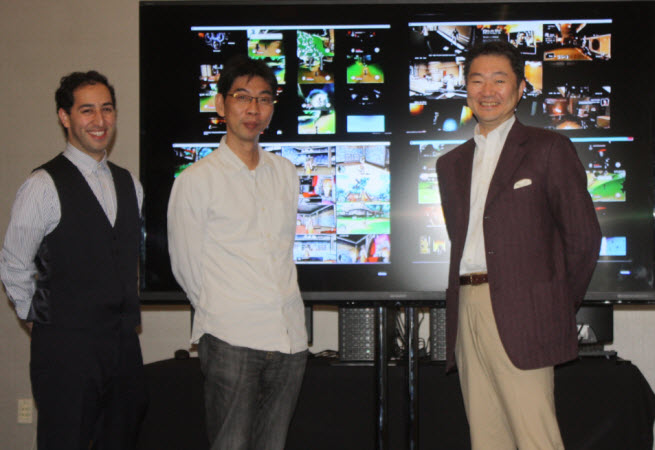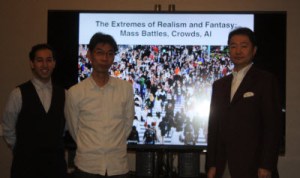Yoichi Wada: The cloud is what is going to lead the game industry. That’s what I believe. However, to make it work, we need content that uses the features of the cloud. We want not only assets from Square Enix, but also work from other developers as well. At the moment, we don’t have a specific business framework, or specific partners. That’s why we did the presentation. We’re actively looking for other developers and business partners to move this thing forward.
We mentioned Ubisoft because they’re the first company to have serious discussions with us in this very early stage. We’re open to having conversations with many other companies. That’s what we’re looking for.
GamesBeat: What about the inconsistent broadband services across the United States? How big a piece of the solution is basically speeding up the networks?
Navok: Improving latency is a major concern for us, but it doesn’t only come from what we do on the game side. We have to work closely with telecom partners, and to the extent possible, be located inside their networks. As we look for partners, we’re particularly looking for those in the fiber optic and fiber-to-home areas, to make sure the quality of service, bandwidth, and low latency result in a gameplay experience that’s satisfactory to our users. As a game publisher ourselves, we want to make sure our games are fun and go to our players at a good enough quality to make them happy.
GamesBeat: Microsoft talked about using 300,000 servers for cloud processing on the Xbox One. How much are you anticipating you’ll need to set up in order to handle large demand?
Navok: The way we’re looking at it is that Square Enix itself is operating on the software layer. We’re not looking to build infrastructure. We’re working with partners who will invest in infrastructure within their networks because we think that makes the most sense in terms of the ecosystem. Telecom companies who are used to making investments in infrastructure, who understand how to run their networks, are the best place to manage and maintain these massive cloud configurations.
GamesBeat: Nvidia is also making a lot of advances with GPUs. They’re multifaceted and can handle a lot of instances at once. Are those things that determine how many instances you have?
Navok: The way we look at it is, as GPU power gets better and cheaper, we can radically increase the number of instances. But we’re not limited to any particular type of GPU or configuration. We consider ourselves to be agnostic. If you look at what’s happening with a lot of the GPU configurations in the cloud, they’re not maximizing the utilization of that processing power. When we run these 16 instances on a single GPU, we’re trying — to the extent possible — to get 100 percent of the calculating power of the GPU out there.
A very interesting thing happens in terms of the price-to-power ratio. From a conceptual standpoint, let’s imagine that you want to run a game that needs a GPU power of six to be at its maximum settings. But the only two GPUs available for you have a maximum power of five or a maximum power of seven. You’re running it in your PC and you want this game to be awesome, so you’ll pay double the price for a GPU with the power of seven, even though you only need six. In the data center, that doesn’t make much sense because we can just add up a bunch of fives, get 30, and then for half the price we’ll have exactly as much power. What we try to do, when we think about processing power — both on the CPU and the GPU side — is find where on the bell curve between price and processing power that we can hit the sweet spot.
GamesBeat: How soon can you deploy this?
Navok: We’re looking at beta tests in the next year or two with our telecom partners. We’re hoping to get into service after that.
GamesBeat: Do you plan on hitting any particular region first?
Navok: We’re looking at North America and, from there, Japan to start. The fiber-optic networks there are very good. We’ll continue to roll out where we see strong broadband potential, fiber, in other areas — Korea, for example, and other parts of Asia.
GamesBeat: Does it matter what kind of hardware a person has? Does it help that more Xbox Ones will be out there, for example?
Navok: It’s an interesting question. For us, we’re what we call a high-workload cloud, so we do all of the rendering and encoding on the servers. We’re only sending a video stream. But we’re neutral on the application layer. We could see ourselves going to a set-top box from telecom companies to next-generation consoles to Steam. What we’re calling the marketing layer, that final layer that touches the consumer, we’re flexible on that.
Wada: When it comes to cloud gaming, we’d like to be very flexible and open-minded. But, when it comes to making content for cloud gaming, we’ll have to be more strict about that. The technology we create, we want it to be very focused. If we don’t do that, I believe that we can’t provide new game experiences to players.
GamesBeat: Your bandwidth consumption when you stream video down, does that wind up being just a fraction of what it otherwise might be?
Navok: The video downstream is the same as basically any high-definition video downstream. Whatever it takes to get that from Netflix and the like is what we need. The upstream data from the controller is very limited. That’s almost nothing.
The real question for us is the latency, how low we can get that in order to make sure the quality of the service is acceptable to the user. It’s very interesting because you can’t cache a game. They’ve created all these content delivery networks all over the world to quickly distribute video to people. But I do believe that we need new solutions for the network to be able to do that for games. It’s one of the things we’re exploring as we speak with telecom companies and other companies involved in networking.




